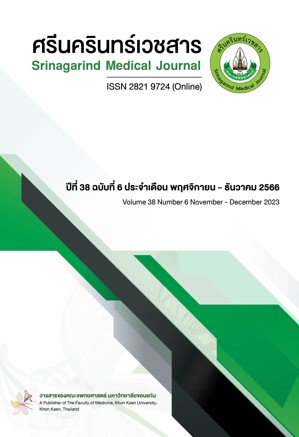Transverse Uterine Fundal Incision During Cesarean Hysterectomy for Women with Placenta Accreta Spectrum Disorder
Keywords:
Transverse uterine fundal incision, classical uterine incision, placenta accrete spectrumAbstract
Background and Objective: Transverse uterine fundal (TUF) incision, a transverse incision made in the uterine fundus, has been proposed for women with placenta accreta spectrum (PAS) disorder. This study assessed the feasibility of TUF incision compared with classical incision (a midline vertical uterine incision).
Methods: This retrospective cohort study reviewed medical records of pregnant women with PAS disorder undergoing cesarean hysterectomy during January 2015 to December 2021 at Faculty of Medicine, Khon Kaen University. Abstract data included baseline characteristics (i.e. PAS grading, types of uterine incision, hysterectomy technique) and maternal and neonatal outcomes.
Results: Thirty-two and fifteen women underwent TUF incision and classical incision, respectively. There was a higher proportion of women in TUF group who had grade 3 PAS than those in classical incision group (75.0% versus 66.7%, respectively). Compared to women undergoing classical incision, although women undergoing TUF incision carried longer operative time (215 min versus 160 min), the rate of massive transfusion were lower (28.1% versus 46.7%). The rate of admission to neonatal intensive care unit were comparable between the two groups. Neonates born to mothers who underwent TUF incision were less likely to experience birth asphyxia (15.6% versus 26.7%).
Conclusion: TUF incision performed during cesarean hysterectomy for PAS disorders appeared to be clinically feasible as it did not increase adverse perioperative outcomes.
References
Jauniaux E, Collins S, Burton GJ. Placenta accreta spectrum: pathophysiology and evidence-based anatomy for prenatal ultrasound imaging. Am J Obstet Gynecol 2018;218(1):75-87. doi:10.1016/j.ajog.2017.05.067.
Kietpeerakool C, Lumbiganon P, Laopaiboon M, Rattanakanokchai S, Vogel JP, Gülmezoglu AM. Pregnancy outcomes of women with previous caesarean sections: Secondary analysis of World Health Organization Multicountry Survey on Maternal and Newborn Health. Sci Rep 2019;9(1):9748. doi:10.1038/s41598-019-46153-4.
Saleh AM, Dudenhausen JW, Ahmed B. Increased rates of cesarean sections and large families: a potentially dangerous combination. J Perinat Med 2017;45(5):517-21. doi: 10.1515/jpm-2016-0242.
Jauniaux E, Chantraine F, Silver RM, Langhoff-Roos J; FIGO Placenta Accreta Diagnosis and Management Expert Consensus Panel. FIGO consensus guidelines on placenta accreta spectrum disorders: Epidemiology. Int J Gynaecol Obstet 2018;140(3):265-73. doi:10.1002/ijgo.12407.
Cheng KK, Lee MM. Rising incidence of morbidly adherent placenta and its association with previous caesarean section: a 15-year analysis in a tertiary hospital in Hong Kong. Hong Kong Med J 2015;21(6):511-7. doi:10.12809/hkmj154599.
Society of Gynecologic Oncology; American College of Obstetricians and Gynecologists and the Society for Maternal–Fetal Medicine, Cahill AG, Beigi R, Heine RP, Silver RM, Wax JR. Placenta Accreta Spectrum. Am J Obstet Gynecol 2018;219(6):B2-B16. doi:10.1016/j.ajog.2018.09.042.
Shukunami K, Hattori K, Nishijima K, Kotsuji F. Transverse fundal uterine incision in a patient with placenta increta. J Matern Fetal Neonatal Med 2004;16(6):355-6. doi: 10.1080/14767050400018189.
Kotsuji F, Nishijima K, Kurokawa T, Yoshida Y, Sekiya T, Banzai M, et al. Transverse uterine fundal incision for placenta praevia with accreta, involving the entire anterior uterine wall: a case series. BJOG 2013;120(9):1144-9. doi:10.1111/1471-0528.12252.
Kan A. Classical Cesarean Section. Surg J (N Y) 2020;6(Suppl 2):S98-S103. doi:10.1055/s-0039-3402072.
Mahesh B, Choong CK, Goldsmith K, Gerrard C, Nashef SA, Vuylsteke A. Prolonged stay in intensive care unit is a powerful predictor of adverse outcomes after cardiac operations. Ann Thorac Surg 2012;94(1):109-16. doi:10.1016/j.athoracsur.2012.02.010.
Verschueren KJ, Kodan LR, Paidin RR, Samijadi SM, Paidin RR, Rijken MJ, et al. Applicability of the WHO maternal near-miss tool: A nationwide surveillance study in Suriname. J Glob Health 2020;10(2):020429. doi:10.7189/jogh.10.020429.
Einerson BD, Branch DW. Surgical Management of Placenta Accreta Spectrum. Clin Obstet Gynecol 2018;61(4):774-82. doi:10.1097/GRF.0000000000000406.
Koshimizu K, Kakogawa J, Murata S, Suzuki M, Suzuki T, Masaoka N. Uterine rupture in the third trimester of a pregnancy subsequent to a cesarean section by transverse uterine fundal incision: A case report and literature review. Clin Case Rep 2022;10(12):e6752. doi:10.1002/ccr3.6752.
Pegu B, Thiagaraju C, Nayak D, Subbaiah M. Placenta accreta spectrum-a catastrophic situation in obstetrics. Obstet Gynecol Sci 2021;64(3):239-47. doi:10.5468/ogs.20345.
Downloads
Published
How to Cite
Issue
Section
License
Copyright (c) 2023 Srinagarind Medical Journal

This work is licensed under a Creative Commons Attribution-NonCommercial-NoDerivatives 4.0 International License.




